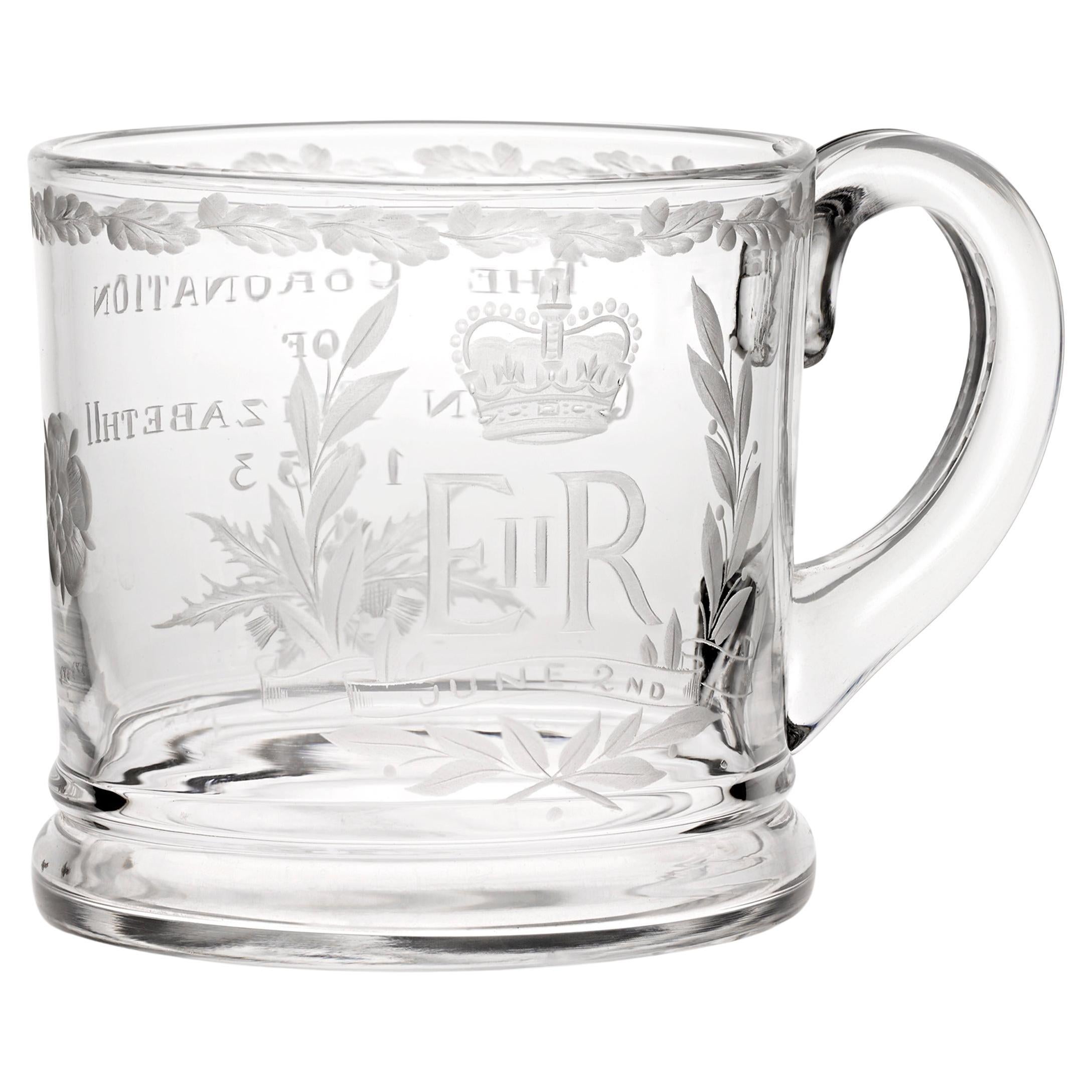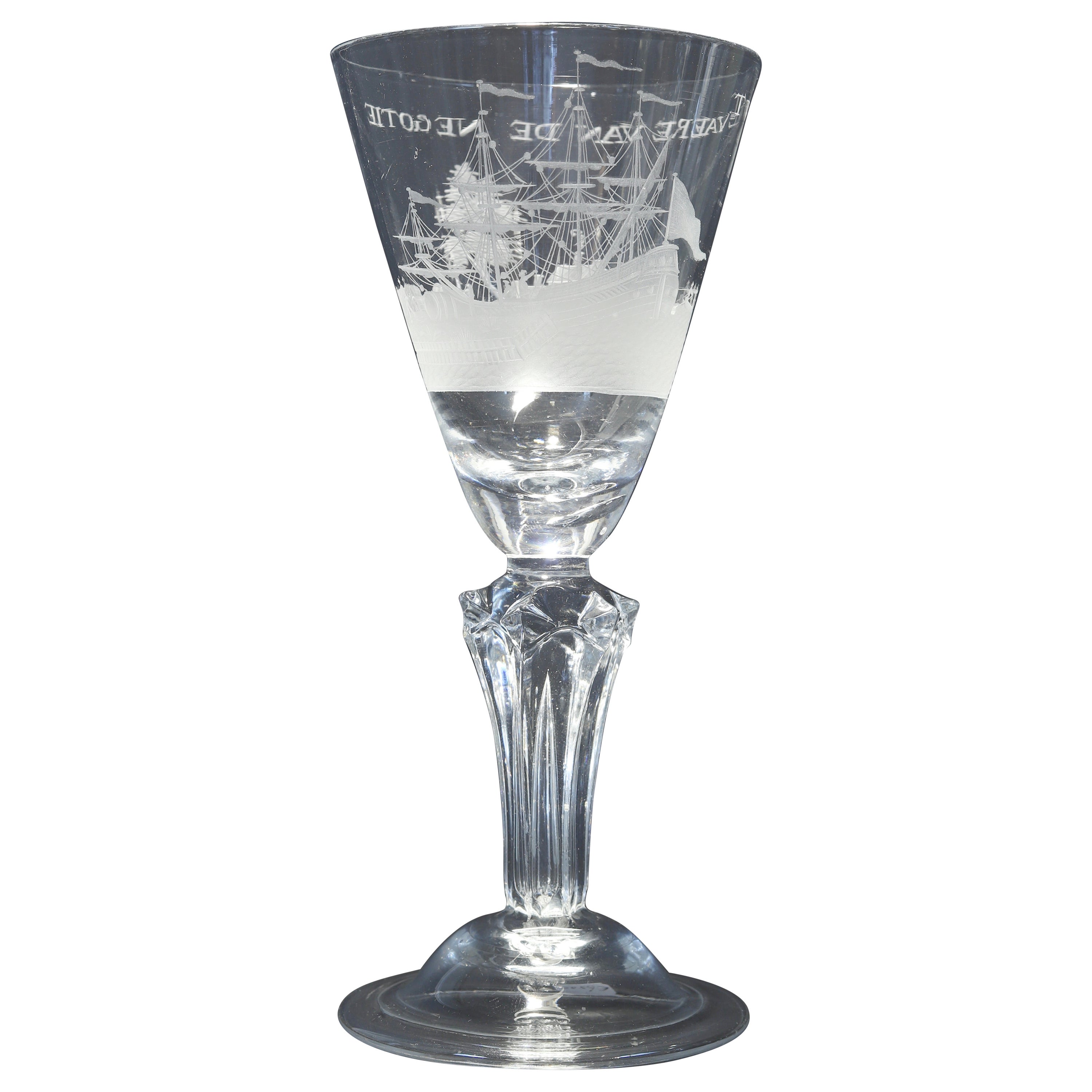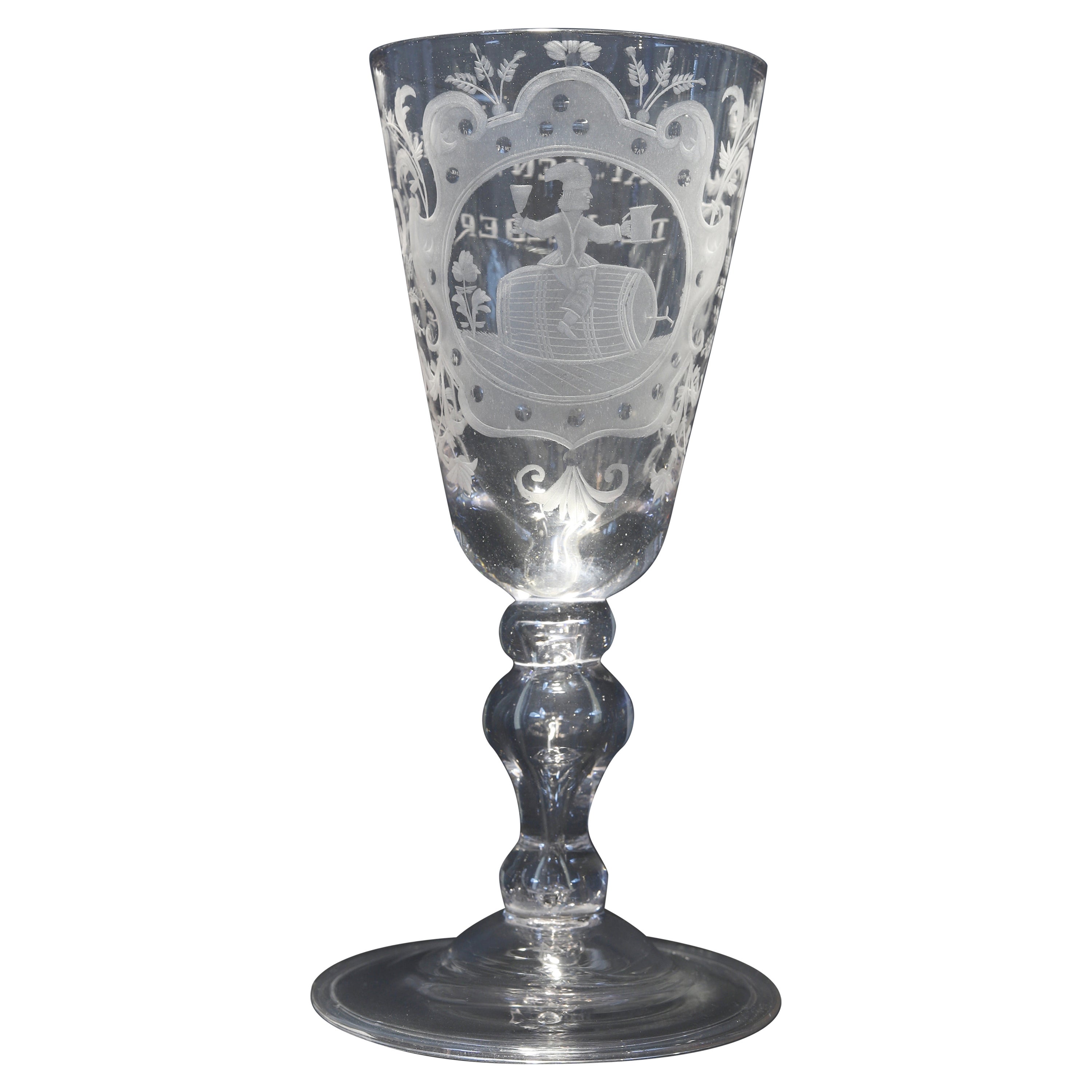Items Similar to Engraved Commemorative Surinam Plantation Glass, History of 18th Century Slavery
Want more images or videos?
Request additional images or videos from the seller
1 of 7
Engraved Commemorative Surinam Plantation Glass, History of 18th Century Slavery
About the Item
A splendid commemorating glass with a fine engraving of a plantation house and coffee shrubs with a text reading: Het.Welvaaren.Van.De.Plantagie.Saxen (the prosperity of the Plantation Saxen)
English or Dutch lead glass, with Dutch wheel-engraving, circa 1750
H. 22.5 cm / Diam. 9.4 cm (cup)
This glass shows that there was a German presence in Surinam, of which the scale is unknown to many.
Without a doubt, the most famous German heading for Surinam must be Frankfurter Maria Sybilla Merian (1647-1717), the artist depicting the tropical flora and fauna. The Dutch historian and abolitionist Julien Wolbers (1819-1889) wrote in his book De Geschiedenis van Suriname (1861: 171-172) that the German migration to Surinam can be seen as a direct result of the migration of Germans to the Netherlands, which was highly constant over a course of four centuries. Images of a coffee plant can’t be found in the oeuvre of Meriam, because around 1720 the first coffee trees were planted by a German-born silversmith named Hansbach.
The flourishing trade in coffee of the 18th century got the German companies focused on Surinam. For instance, Georg Heinrich Sieveking, a Hamburger merchant, imported coffee and cotton from Surinam. In the spring of 1782, he sent a ship to Surinam under Captain Rohlap, with 8.000 Deutschmark, which returned the same year with coffee, sugar, and cotton. Estimated upon arrival: 125.000 Deutschmark. This sparked more interest in Surinam by the Germans, and the Dutch made use of this by inviting them to invest or settle since it was already hard enough for them to find enough Dutch to fully exploit the lands and enslaved people bought in Africa.
‘Saxen’ was a plantation in Surinam along the Tapoeripa creek, spanning over 500 akkers (c. 225 acres) in 1819, 300 akkers in 1827, and deserted in 1830. It was also a German-owned plantation and produced cotton and coffee. The earliest mention of an owner is J.G. Clemen, the name-giver of the Surinam family Nemelc, simply turning around his own name and giving it to his 'belongings'. In the 19th century the owners were F. C. Stolkert and R. le Chevalier. Other German plantations are Altona, Badenstein, Berlijn (Para), Berlijn (Ben.Commewijne), Bremen, Charlottenburg, Duisburg, Frankfort, Halle in Saxen, Hamburg (Cottica), Hamburg (Saramacca), Hanover, Hildesheim, Kleinhausen, Lunenburg, Maagdenberg, Mannheim, Munchenstein (Zwitserland), Nieuw-Altona, Oldenburg, Onverwacht & Duisburg, Saltzhagen and another Saxen, but Halle in Saxen.
On an important large hand-drawn map in our collection, by Heinrich Heimcke dated 1830, the plantation Saxen is indicated as 'grond van Saxen' (ground of Saxen), so called because in 1830 the plantation had just been deserted.
- Dimensions:Height: 3.71 in (9.4 cm)Diameter: 8.86 in (22.5 cm)
- Materials and Techniques:Glass,Engraved
- Place of Origin:Suriname
- Period:
- Date of Manufacture:circa 1750
- Condition:Perfect condition.
- Seller Location:Amsterdam, NL
- Reference Number:1stDibs: LU5458229747242
About the Seller
5.0
Vetted Seller
These experienced sellers undergo a comprehensive evaluation by our team of in-house experts.
Established in 1985
1stDibs seller since 2020
19 sales on 1stDibs
Typical response time: 3 hours
- ShippingRetrieving quote...Ships From: Amsterdam, Netherlands
- Return PolicyThis item cannot be returned.
More From This SellerView All
- Engraved 'Cape of Good Hope' Colonial Commemorative Glass, 18th CenturyLocated in Amsterdam, NLA commemorating glass with an engraving of a farmer ploughing, an East Indiaman and a text reading: Het Lan’s Wel Varen An De Caap (the country’s prosperity at the Cape of Good Hope...Category
Antique 18th Century South African Glass
MaterialsGlass
- Extremely Large Hand-Drawn Manuscript Map of Surinam, 1830, History of SlaveryLocated in Amsterdam, NLA unique large hand-drawn map of Surinam by Albrecht Helmut Hiemcke (German, 1760-1839) ? 'Colonie Surinaame', 1830 A large hand-drawn and coloured map of the colony of Suri...Category
Antique Mid-19th Century Surinamer Maps
MaterialsPaper
- An extremely rare 18th century drawing of a DodoLocated in Amsterdam, NLAn extrmely rare drawing of a Dodo Second half 18th century Pen and ink, and watercolour on paper, H. 18 x W. 12.2 cm With text reading: “This bird was seen in Mauritius by Sir Th Herbert about 1589 – there are Remains of the bill + legs in the Museum at Oxford – but.– it is near 200 years since any specimen has been brought to England. The Draw(ing) is made from a Dutch Painting in the British Museum – (?) J. A. says that it is eaten but the flesh is oily + unpleasant –” “The Dodo...Category
Antique 18th Century British Drawings
MaterialsPaper
- Japanese Sculpture Okimono of a Dutchman, Dutch Colonial, 18th CenturyLocated in Amsterdam, NLAn extremely rare wood Japanese Okimono of a Dutchman playing with a bat Edo period, 18th-19th century or earlier The Dutchman is standing and h...Category
Antique Early 18th Century Japanese Edo Sculptures and Carvings
MaterialsBoxwood
- 18th Century Polynesian Ironwood Gata Waka or War Club from FijiLocated in Amsterdam, NLA Polynesian ironwood Gata waka or war club Fiji, probably 18th century or earlier Measures: Height. 97 cm Including museum-quality powder-coated stand. Provenance: Private collection, France Polynesian culture is traditionally a culture of power and prestige, and there was a fine line between battle and ceremony. Warrior people par excellence, the Fijians had at their disposal a large panoply of weapons, each for a specific use. The elegant Gata are called gun-sticks by Europeans due to the recognizable form. However, they are designed after a snake, gata in Fijian language. The Ula throwing clubs...Category
Antique 18th Century Fijian Tribal Art
MaterialsHardwood
- 18th Century Polynesian Hardwood Ula Tavatava or Throwing War Club from FijiLocated in Amsterdam, NLA Polynesian hardwood Ula tavatava or throwing war club Fiji, probably 18th century All-over decorated in incised pattern, the bulbous top seems to have a stone grown into it. H. 42 cm Including museum-quality powder-coated stand. Provenance: Private collection, France Polynesian culture is traditionally a culture of power and prestige, and there was a fine line between battle and ceremony. Warrior people par excellence, the Fijians had at their disposal a large panoply of weapons, each for a specific use. The elegant Gata are called gun-sticks by Europeans due to the recognizable form. However, they are designed after a snake, gata in Fijian language. The Ula throwing clubs...Category
Antique 18th Century Fijian Tribal Art
MaterialsHardwood
You May Also Like
- Coronation of Queen Elizabeth II Commemorative GlassLocated in New Orleans, LAThis engraved glass was crafted to commemorate the coronation of Queen Elizabeth II. Sixteen years following the coronation of her father, King George VI, the official coronation of Queen Elizabeth II represented a fascinating mix of tradition and modernity. Held at Westminster Abbey, it was the first official celebration of its kind ever to be televised — approximately 27 million people in the United Kingdom alone tuned in to watch their new Queen don her crown for the first time. Considering the widespread popularity of the event, commemorative objects such as this became highly desirable, as people around the world sought remembrances of the joyous occasion. This glass is an exceptional example of its type that remains in excellent condition. One side reads "The Coronation of Queen Elizabeth 1953," while the other displays the initials "ER II...Category
20th Century English Historical Memorabilia
MaterialsGlass
- A Dutch Engraved Baluster Wine Glass, Mid 18th CenturyLocated in AMSTERDAM, NHEngland, Newcastle Engraving: English or Dutch Mid 18th century A heavy baluster Dutch? engraved wine glass with a bell-shaped bowl, the rim decorated with garlands, floral ornament...Category
Antique Mid-18th Century English Rococo Glass
MaterialsGlass
- A Dutch Engraved Prosperity of the Trade Wine Glass, Mid 18th CenturyLocated in AMSTERDAM, NHGerman, Saxon Engraving: Dutch Mid 18th century A Saxon, Dutch engraved wine glass; the thistle bowl with a solid faceted base, decorated with a formal c...Category
Antique Mid-18th Century German Rococo Glass
MaterialsGlass
- A Dutch Engraved, Prosperity of the Trade, Wine Glass, Early 18th CenturyLocated in AMSTERDAM, NHThe Netherlands or England Engraving: Dutch Circa 1730 - 1740 An exceptional fine Dutch engraved moulded stem wine glass, with a pointed round funnel bowl with a solid base enclosin...Category
Antique 1730s Dutch Rococo Glass
MaterialsGlass
- A Dutch Engraved Baluster, Ceremonial Pregnancy Wine Glass, 18th CenturyLocated in AMSTERDAM, NHThe Netherlands Engraving: Dutch Mid 18th century A large Dutch engraved baluster wine glass, with a large funnel bowl with the decoration of a formal cartouche with a seated little guy on a wine barrel drinking and toasting, set on a thick stem with three knops of which the middle one tears down, on a conical folded foot. With on the foot an engraving of an inversed 4 and IXXXX on the foot rim. Inscribed: Vivat Hensel in de Kelder: Long Live Little Hans in the Cellar This popular subject on Dutch wine glasses...Category
Antique Mid-18th Century Dutch Rococo Glass
MaterialsGlass
- A Dutch Engraved Baluster, Prosperity of the Country, Wine Glass, 18th CenturyLocated in AMSTERDAM, NHThe Netherlands Engraving: Dutch Mid 18th century A Dutch engraved baluster wine glass, with a tall pointed round funnel bowl with a solid base, d...Category
Antique Mid-18th Century Dutch Rococo Glass
MaterialsGlass





